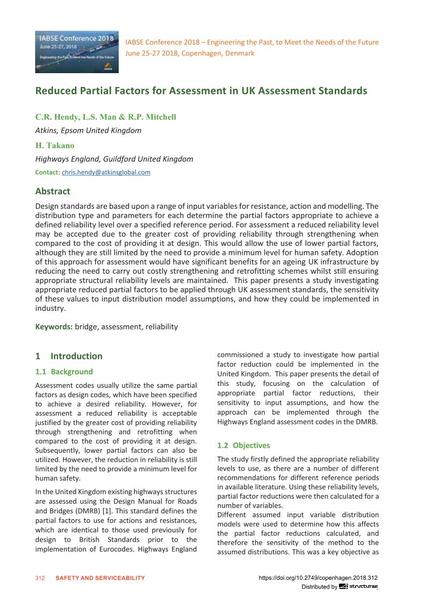Reduced Partial Factors for Assessment in UK Assessment Standards

|
|
|||||||||||
Détails bibliographiques
| Auteur(s): |
C. R. Hendy
(Atkins, Epsom United Kingdom)
L. S. Man (Atkins, Epsom United Kingdom) R. P. Mitchell (Atkins, Epsom United Kingdom) H. Takano (Highways England, Guildford United Kingdom) |
||||
|---|---|---|---|---|---|
| Médium: | papier de conférence | ||||
| Langue(s): | anglais | ||||
| Conférence: | IABSE Conference: Engineering the Past, to Meet the Needs of the Future, Copenhagen, Denmark, 25-27 June 2018 | ||||
| Publié dans: | IABSE Conference Copenhagen 2018 | ||||
|
|||||
| Page(s): | 312-319 | ||||
| Nombre total de pages (du PDF): | 8 | ||||
| DOI: | 10.2749/copenhagen.2018.312 | ||||
| Abstrait: | Design standards are based upon a range of input variables for resistance, action and modelling. The distribution type and parameters for each determine the partial factors appropriate to achieve a defined reliability level over a specified reference period. For assessment a reduced reliability level may be accepted due to the greater cost of providing reliability through strengthening when compared to the cost of providing it at design. This would allow the use of lower partial factors, although they are still limited by the need to provide a minimum level for human safety. Adoption of this approach for assessment would have significant benefits for an ageing UK infrastructure by reducing the need to carry out costly strengthening and retrofitting schemes whilst still ensuring appropriate structural reliability levels are maintained. This paper presents a study investigating appropriate reduced partial factors to be applied through UK assessment standards, the sensitivity of these values to input distribution model assumptions, and how they could be implemented in industry. | ||||
| Mots-clé: |
pont
|
||||
